Gandhi: The Decolonisation of India - Full Game Playthrough
Introduction
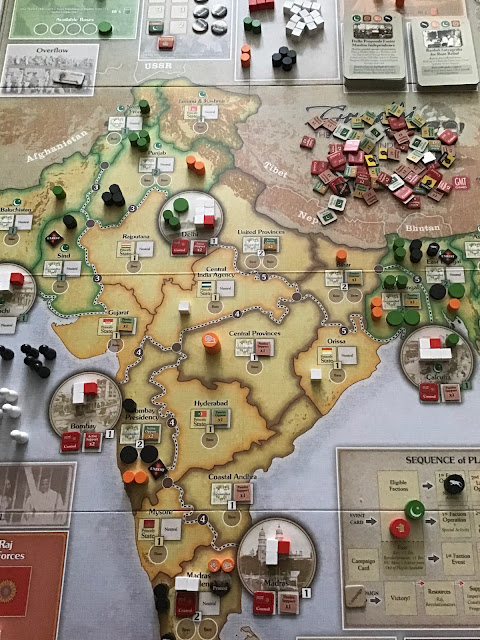
Turn 2 - 2nd Action - Muslim League - Rally Operation + Infiltrate Special Activity
---
Gandhi: Turn 3 - Gandhi’s Rallying Cry Answered
Turn 3 - 1st action - Congress - Operation: Rally
Turn 3 - 1st action - Congress - Special Activity: Satyagraha
Turn 3 - 2nd Action - Revolutionaries - Limited Operation: Attack
---
Gandhi: Turn 4 - Raj Forces Head to the North
Turn 4 - 1st Action - Raj - Operation: Deploy
Turn 4 - 1st Action - Raj - Special Ability: Martial Law
Turn 4 - 2nd Action - Muslim League - Play Event: Quit India Movement
---
Turn 5 - 2nd Action - Congress - Special Ability: Persuade
Turn 5 - 2nd Action - Congress - Operation: Rally
---
Gandhi: Turn 6: Linlinthgow Cracks the Whip
Turn 6 - 1st Action - Raj - Operation: Sweep
Turn 6 - 1st Action - Raj - Special Ability: Martial Law
Turn 6 - 2nd Action - Muslim League - Pass
---
Gandhi : Campaign Round 1 - Linlithgow Summoned Home
The following series of programmed steps take place:
Gandhi: Turn 7 - The Pakistan Declaration
Turn 7 - 1st Action - Muslim League - Play Event: Pakistan Declaration Published in London
Turn 7 - 2nd Action - Congress - Operation: Rally
Turn 7 - 2nd Action - Congress - Special Ability: Persuade
---
Gandhi: Turn 8 - Spies in our Midst
Turn 8 - 1st Action - Raj - Play Event: Independence Fighters Take Up Arms
Turn 8 - 2nd Action - Revolutionaries - Operation: Rally
Turn 8 - 2nd Action - Revolutionaries - Special Ability: Infiltrate
Turn 11 - 1st Action - Muslim League - Operation: Civil Disobedience
Turn 11 - 1st Action - Muslim League - Special Activity: Infiltrate
Turn 11 - 2nd Action - Congress - Play Event
---
Gandhi: Turn 12 - British Take a Pinch of Salt
Turn 12 - 1st Action - Raj - Play Event
Turn 12 - 2nd Action - Revolutionaries - Pass
The Revolutionaries have a powerful event coming up next turn. They pass to allow themselves the chance to enact it. A quiet turn comes to a swift end.
---
Gandhi: Turn 13 - Levels of Unrest Grow
Turn 13 - 1st Action - Revolutionaries - Play Event
Turn 13 - 2nd Action - Muslim League - Pass
The Muslim League sense the next card, which they would be able to enact, could be powerful. They pass and the turn comes to an end.
---
Gandhi: Turn 14 - Infiltration, non-cooperation and assassination
Turn 14 - 1st Action - Muslim League - Special Ability: Infiltrate
Revolutionaries: 5 points (-10)
Congress: 4 points (-17)
Muslim League: 0 points (-15)
The Revolutionaries are the nearest to victory but none of the factions is close.
Turn 28 - 1st Action - Congress - Operation: Civil Disturbance (Part 1)
Turn 28 - 1st Action - Congress - Special Activity: Satyagraha
Turn 28 - 1st Action - Congress - Operation: Civil Disturbance (Part 2)
Turn 28 - 2nd Action - Muslim League - Play Event
With both unity and restraint at 1, India has descended into crisis.
Turn 28 - Crisis
Gandhi: Turn 29 - Carrot and Stick Approach from the Raj Reaps Rewards
Turn 29 - 1st Action - Raj - Special Activity: Govern
Gandhi: Turn 32 - Gandhi Tries to Muster Support but Raj Gains in Strength
—
Gandhi: Turn 36 - Sepoys Impose Martial Law as Support for Gandhi Swells
Turn 36 - 1st Action - Raj - Operation: Deploy
Turn 36 - 1st Action - Raj - Special Activity: Martial Law
Turn 36 - 2nd Action - Congress - Play Event
—
Gandhi: Turn 37 - Revolutionary Forces Spread Cross Country
Turn 37 - 1st Action - Revolutionaries - Special Activity: Infiltrate
Turn 37 - 1st Action - Revolutionaries - Operation: March
Turn 37 - 2nd Action - Muslim League - Limited Operation: Demonstrate
—
Gandhi: Turn 38 - Gandhi Jailed while Raj Clears Punjab of its Opponents
Turn 38 - 1st Action - Raj - Operation: Assault
Turn 38 - 1st Action - Raj - Special Activity: Govern [followed by automatic Congress Protests]
Turn 38 - 2nd Action - Congress - Limited Operation: Rally
Turn 42 - 1st Action - Revolutionaries - Operation: Attack
Turn 42 - 2nd Action - Congress - Pass
In a risky move, Congress decides to pass so they can carry out a full action in the next turn, when they are first player. However, if the next card turned up is the last Campaign card, they won’t get the chance to act.
Turn 43 - 1st Action - Congress - Special Activity: Negotiate
Turn 43 - 2nd Action - Raj - Assault
—

The Covid-19 lockdown demanded a project, a way of occupying me in those moments when the isolation and anxiety needed an outlet. The idea that emerged was to play a solo board game and record the narrative of the emerging story.
It also provided the perfect excuse to explore GMT Games’ COIN series, which had always tempted me but into which I had never jumped.
I bought Falling Sky, their game about Caesar’s campaign in Gaul, tracking the play turn-by-turn on Twitter for the first part of the game.
Twitter in the end felt like the wrong channel. My endless tweets became tiresome. So I decided to move towards a blog, which felt less intrusive. I also used the opportunity to buy a second COIN, so impressed had I been by Falling Sky.
I chose Gandhi: The Decolonisation of India, 1917-1947. I set up this blog to track the turn-by-turn play of that game, a process which continues; as I write this, I am about half way through and, as the British, I am getting a pasting.
It is a project to help me through the Covid-19 lockdown, played in fits and starts, a turn or two a day.
I was sure it would provide me with distraction and entertainment.
What I didn’t expect was that the medium of a board game would be the inspiration for me to engage for the first time with the history of India’s independence movement.
I mash up the rules, no doubt, I make awful game-play decisions, no doubt, I create incomprehensible posts with indecipherable accompanying graphics, no doubt. I also have a huge amount of fun, without a doubt.
What you’re reading here is a compilation of all those individual posts into a single entry, to which I add every time I play a new turn. If you stumble across this, please indulge my mistakes.
If you’re wondering whether to play a COIN game, never having done so, I hope this gives you a taste. I also hope you do choose to play a COIN game. They are remarkable.
---
It also provided the perfect excuse to explore GMT Games’ COIN series, which had always tempted me but into which I had never jumped.
I bought Falling Sky, their game about Caesar’s campaign in Gaul, tracking the play turn-by-turn on Twitter for the first part of the game.
Twitter in the end felt like the wrong channel. My endless tweets became tiresome. So I decided to move towards a blog, which felt less intrusive. I also used the opportunity to buy a second COIN, so impressed had I been by Falling Sky.
I chose Gandhi: The Decolonisation of India, 1917-1947. I set up this blog to track the turn-by-turn play of that game, a process which continues; as I write this, I am about half way through and, as the British, I am getting a pasting.
It is a project to help me through the Covid-19 lockdown, played in fits and starts, a turn or two a day.
I was sure it would provide me with distraction and entertainment.
What I didn’t expect was that the medium of a board game would be the inspiration for me to engage for the first time with the history of India’s independence movement.
I mash up the rules, no doubt, I make awful game-play decisions, no doubt, I create incomprehensible posts with indecipherable accompanying graphics, no doubt. I also have a huge amount of fun, without a doubt.
What you’re reading here is a compilation of all those individual posts into a single entry, to which I add every time I play a new turn. If you stumble across this, please indulge my mistakes.
If you’re wondering whether to play a COIN game, never having done so, I hope this gives you a taste. I also hope you do choose to play a COIN game. They are remarkable.
---
Gandhi: Turn 1 - A revolution is brewing
Gandhi: The Decolonisation of India has two scenarios. A short game that starts in 1930 and the long version that starts in 1917.
I’m going for the long version and playing the British. An elegant, automated non-player system will select the actions of the three non-player factions.
I don’t intend explaining the rules in detail but hope they emerge in broad terms through the playthrough. The GMT Games website contains the rule book, several articles outlining tactics and couple of explainer videos.
Game turns are driven by cards, with the current turn dictated by the card on the right. The card on the left is also revealed to show what is coming up; this knowledge can influence the decisions factions take.

Turn 1 - 1st action - Revolutionaries - Special Activity: Infiltrate
Turn 1 - 1st action - Revolutionaries - Operation: Attack
Turn 1 - 2nd Action - Congress - Demonstrate
Gandhi: The Decolonisation of India has two scenarios. A short game that starts in 1930 and the long version that starts in 1917.
I’m going for the long version and playing the British. An elegant, automated non-player system will select the actions of the three non-player factions.
I don’t intend explaining the rules in detail but hope they emerge in broad terms through the playthrough. The GMT Games website contains the rule book, several articles outlining tactics and couple of explainer videos.
Game turns are driven by cards, with the current turn dictated by the card on the right. The card on the left is also revealed to show what is coming up; this knowledge can influence the decisions factions take.

Turn 1 - 1st action - Revolutionaries - Special Activity: Infiltrate
 |
| The Revolutionaries take the first step and it’s an aggressive one. A charismatic young Indian lawyer has started to make a name for himself leading a fledgling non-violent movement against the British Raj. The first of his protests have sprung up in Bombay Presidency. Non-violence is not, however, on the Revolutionaries’ agenda. Using their Infiltrate special action, they get amongst Gandhi’s early supporters and turn some of them towards their more violent methods. |
Turn 1 - 1st action - Revolutionaries - Operation: Attack
 |
| Having weakened the resolve of the Indian National Congress, the Revolutionaries increase their attack in Bombay Presidency and, with protests already taking place in the province, see the levels of unrest increase (denoted by the placing of the ‘unrest’ marker). |
 |
| Unsettled by the flare up of violence so close to their leader in Bombay Presidency, Congress activists get to act second this turn. They choose to demonstrate, marching from the nearby city of Bombay. They are able to bring Muslim League supporters, who are equally aghast at the Revolutionaries‘ aggression. The British watch on bemused as Bombay empties of activists. |
---
Gandhi: Turn 2 - Constitutional Reforms
Turn 2 - 1st Action - British - Play Event: Simon Commission Report
Gandhi: Turn 2 - Constitutional Reforms
Turn 2 - 1st Action - British - Play Event: Simon Commission Report
 |
| The Raj seeks to quell the emerging trouble through the imposition of constitutional changes. Lord Simon’s Commission proposes provincial autonomy to draw the sting from the Indian sense of grievance. The report placates activists, who melt away in Delhi and Calcutta, while the protests and unrest in Bombay Presidency end. It’s a significant early victory for the British civil service. This is one of those instances where war games such as this present alternative histories. For a start, the Simon Commission convened a decade later than the date of the current game state. It was widely rejected as no Indians featured on the Commission. If this card is played by a non-British faction, it in fact increases levels of activism and unrest, to reflect that unpopularity. As it is, the version of history imagined in this playthrough posits that the Commission’s findings proved popular, which is why four activists, a protest marker and an unrest marker are removed from the board. |
Turn 2 - 2nd Action - Muslim League - Rally Operation + Infiltrate Special Activity
 |
| The Muslim League’s first steps are to start building activist numbers in the north. A rally action recruits support in Karachi, Calcutta and Punjab. They follow up in the latter to infiltrate a sepoy unit which abandons its British pay-masters. |
---
Gandhi: Turn 3 - Gandhi’s Rallying Cry Answered
Turn 3 - 1st action - Congress - Operation: Rally
 |
| The impact of the Simon Commission was short-lived. The mood in India is calm and Gandhi, sensing complacency in the British, rallies support around him in Bombay Presidency and in four provinces in the north, where political tensions with the Muslim League look set to surface. |
Turn 3 - 1st action - Congress - Special Activity: Satyagraha
 |
| For now, Gandhi’s work around Bombay is done. He embarks on a long march north to the Punjab where his arrival attracts a new activist to his cause. |
Turn 3 - 2nd Action - Revolutionaries - Limited Operation: Attack
 |
| With Gandhi now in the north, the Revolutionaries turn their attention back to the Bombay Presidency where they launch an attack. It’s poorly coordinated, however, and comes to nothing. |
---
Gandhi: Turn 4 - Raj Forces Head to the North
Turn 4 - 1st Action - Raj - Operation: Deploy
 |
| The British start to get nervous at the concentration of activists in the Punjab and East Bengal, so deploy large numbers of sepoys, supported by some British army troops, to Delhi and Calcutta. |
Turn 4 - 1st Action - Raj - Special Ability: Martial Law
Turn 4 - 2nd Action - Muslim League - Play Event: Quit India Movement
 |
| The Muslim League, usually a non-violent movement, reacts with fury to the crackdown in East Bengal. That fury erupts in Punjab where a nascent Quit India Movement [in reality it actually emerged in the 1940s and was opposed by the Muslim League; for this playthrough we must finesse that history!] results in sporadic violence and the hasty retreat of British forces. The Raj has lost control of the Punjab. |
---
Gandhi: Turn 5 - Raj Loses Control of Karachi
Turn 5 - 1st Action - Revolutionaries - Play Event: Chauri Chaura Massacre
Turn 5 - 2nd Action - Congress - Special Ability: Persuade
Turn 5 - 2nd Action - Congress - Operation: Rally
---
Gandhi: Turn 6: Linlinthgow Cracks the Whip
Turn 6 - 1st Action - Raj - Operation: Sweep
 |
| Linlithgow moves swiftly to reassert dominance. He sweeps troops from Delhi and Calcutta back into Punjab and the two Bengal provinces, exposing hidden guerrillas and returning the provinces to Raj control. |
Turn 6 - 1st Action - Raj - Special Ability: Martial Law
 |
| Once again taking advantage of Linlithgow’s ability not to create unrest when using martial law, the Raj clears Punjab and East Bengal of activists. British military might and aggression look to have pushed back the non-violent tide for now. |
Turn 6 - 2nd Action - Muslim League - Pass
 |
| The Muslim League can act now but want to remain eligible to play the forthcoming card in the next turn. They pass in preparation. |
---
Gandhi : Campaign Round 1 - Linlithgow Summoned Home
The following series of programmed steps take place:
- Check for victory
None of the factions is near their target.
---
- Resources Phase
- Redeploy Phase
- Reset Phase
---
Gandhi: Turn 7 - The Pakistan Declaration
Turn 7 - 1st Action - Muslim League - Play Event: Pakistan Declaration Published in London
 |
| For the first time, the word ‘Pakstan’ is used in Choudhry Rahmat Ali’s Pakistan Declaration pamphlet. He writes: ‘Our religion and culture, our history and tradition, our social code and economic system, our laws of inheritance, succession and marriage are fundamentally different from those of most peoples living in the rest of India.’ Congress is horrified but Ali’s manifesto leads to two new Muslim League bases in Punjab and East Bengal. |
Turn 7 - 2nd Action - Congress - Operation: Rally
 |
| Gandhi lays down an early challenge to the new Governor-General, rallying supporters to himself in East Bengal and prompting further expressions of support in Karachi, Hyderabad and Sind. |
Turn 7 - 2nd Action - Congress - Special Ability: Persuade
 |
| With the surge in support, Congress starts to work on its opponents, exposing a guerrilla unit in Bombay Presidency and persuading a Sepoy unit to return to their homes. |
---
Gandhi: Turn 8 - Spies in our Midst
Turn 8 - 1st Action - Raj - Play Event: Independence Fighters Take Up Arms
Turn 8 - 2nd Action - Revolutionaries - Operation: Rally
 |
| The suppression of the rebels turns out to be a disaster. The Revolutionaries rally and, energised by outrage at the Raj’s brutality, new guerrilla units spring up in almost all corners of India. Lord Irwin has poked a virulent hornet’s nest. Is worse to come? |
Turn 8 - 2nd Action - Revolutionaries - Special Ability: Infiltrate
---
Gandhi: Turn 9 - Seeking Supremacy in Bombay Presidency
Turn 9 - 1st Action - Congress - Operation: Rally
Turn 9 - 1st Action - Congress - Special Activity: Satyagraha
Turn 9 - 2nd Action - Muslim League - Play Event
---
Gandhi: Turn 10 - Mass Troop Movement in North
Turn 10 - 1st Action - Raj - Command: Deploy
Turn 10 - 1st Action - Raj: Special Ability: Treaty
Turn 10 - 2nd Action - Revolutionaries - Limited Operation: Attack
Gandhi: Turn 9 - Seeking Supremacy in Bombay Presidency
Turn 9 - 1st Action - Congress - Operation: Rally
 |
| Gandhi has few pieces readily available but, using what he has, he continues to exploit the ongoing protests in Bombay Presidency to drum up additional supporters. |
Turn 9 - 1st Action - Congress - Special Activity: Satyagraha
 |
| Gandhi continues to shuttle from east to west and back again, travelling to the Punjab once more and raising fresh support there. Congress now has a presence in large parts of India but can they convert that into opposition? |
Turn 9 - 2nd Action - Muslim League - Play Event
 |
| The re-establishment of bases in Muslim regions has created some momentum for the Muslim League. Even so, the British Raj could not have imagined the raft of Sepoy desertions from Punjab and Bengal. |
---
Gandhi: Turn 10 - Mass Troop Movement in North
Turn 10 - 1st Action - Raj - Command: Deploy
Turn 10 - 1st Action - Raj: Special Ability: Treaty
Turn 10 - 2nd Action - Revolutionaries - Limited Operation: Attack
 |
| The British do not want to allow the Revolutionaries, who play next, the chance to implement the event card, which would allow them to place another base. Therefore, they choose not to use a Special Activity. This restricts the rebels to a single limited operation in just one area. Limited geographically, it may be, but the attack is not limited in effect. Four guerrilla units are activated and, in a violent assault, two Sepoy units are killed. |
---
Gandhi: Turn 11 - Muslim Protests and Failed Talks
Gandhi: Turn 11 - Muslim Protests and Failed Talks
Turn 11 - 1st Action - Muslim League - Operation: Civil Disobedience
 |
| The ground work laid by placing their bases now pays off for the Muslim League: they provide the infrastructure for a wave of protests in the Punjab and Bengal. Muslim and Congress activists are flipped to their active side and, with their forces now outnumbered by protestors, the Raj loses control of these pivotal provinces. |
Turn 11 - 1st Action - Muslim League - Special Activity: Infiltrate
 |
| The Muslim resurgence in West Bengal takes hold as another successful infiltration converts another Sepoy unit to the separatist cause. In Whitehall, questions are being asked as to why Linlithgow’s term as Governor-General was brought to an end. |
Turn 11 - 2nd Action - Congress - Play Event
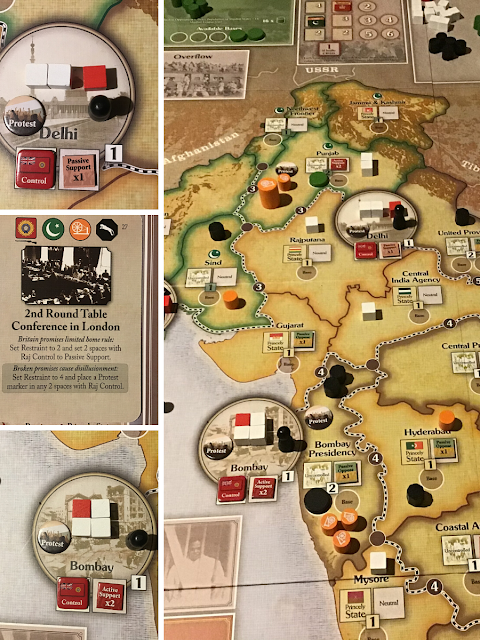 |
| The cerebral Irwin tries to talks his way to a solution. The Gandhi-Irwin pact results in the British Government calling a round table conference in London to discuss power sharing proposals. However, there is to be no meeting of minds. Winston Churchill describes it as a “nauseating and humiliating spectacle.” Back in India, the break-up of talks and the harsh words from Tory politicians prompt protests in Delhi and Bombay. |
---
Gandhi: Turn 12 - British Take a Pinch of Salt
Turn 12 - 1st Action - Raj - Play Event
 |
| The British know this could be a long campaign and, with the ‘restraint’ level a ‘4’, the cost of acting is expensive. They therefore turn to economic warfare, refusing to relax the despised salt tax and raising 20 resource points, doubling their total in the process. |
Turn 12 - 2nd Action - Revolutionaries - Pass
The Revolutionaries have a powerful event coming up next turn. They pass to allow themselves the chance to enact it. A quiet turn comes to a swift end.
---
Gandhi: Turn 13 - Levels of Unrest Grow
Turn 13 - 1st Action - Revolutionaries - Play Event
 |
| Reactionary elements within the Revolutionaries use the furore raised by Gandhi’s Harijan Campaign to end untouchability to raise levels of unrest in East Bengal and Bombay Presidency. It’s a problem not just for the Raj but for the two non-violent factions: the Revolutionaries increase their score to 7 points (they gain points for the population levels of regions in a state of ‘unrest’). Another 8 points are all they need to be in a winning position. |
Turn 13 - 2nd Action - Muslim League - Pass
The Muslim League sense the next card, which they would be able to enact, could be powerful. They pass and the turn comes to an end.
---
Gandhi: Turn 14 - Infiltration, non-cooperation and assassination
Turn 14 - 1st Action - Muslim League - Special Ability: Infiltrate
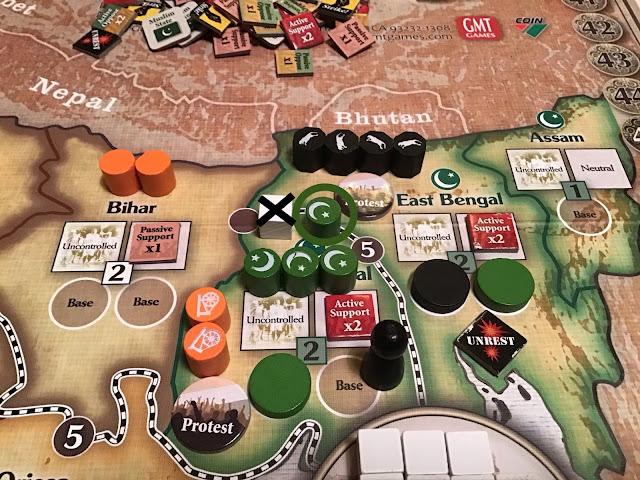 |
| Instead of taking the action (which would have seen Sir Michael O’Dwyer assassinated), the Muslim League continues to develop its strength in West Bengal. Theythey infiltrate the last remaining Sepoy unit there, which shows no inclination to remain loyal to the Raj. |
Turn 14 - 1st Action - Muslim League - Operation: Non-Cooperation
Turn 14 - 2nd Action - Congress - Play Event
Turn 14 - 2nd Action - Congress - Play Event
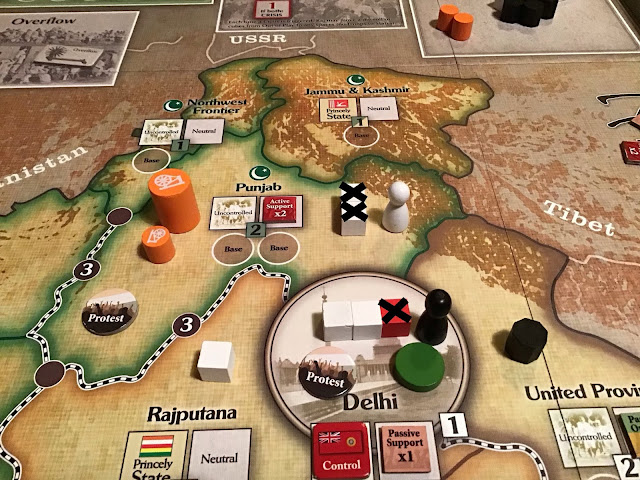 |
| Sir Michael O’Dwyer avoids assassination for just a short period, shot dead in central London by an Indian revolutionary, Udham Singh. Gandhi calls it an “act of insanity” but the repercussions nonetheless play to Congress’ advantage: a troop unit in Delhi and two Sepoy units in Punjab are diverted away from their military duties and forced to police the growing protests in those two increasingly febrile areas. |
---
Gandhi: Turn 15: Bureaucratic Manoeuvres
Turn 15 - 1st Action - Raj - Operation: Sweep
Turn 15 - 1st Action - Raj - Special Activity: Govern
Turn 15 - 2nd Action - Revolutionaries - Play Event
---
Gandhi: Turn 16 - Massacre Stokes Sikh Fury
Turn 16 - 1st Action - Congress - Play Event
Turn 16 - 2nd Action - Muslim League - Operation: Demonstrate
Turn 16 - 2nd Action - Muslim League - Special Activity: Infiltrate
Gandhi: Turn 15: Bureaucratic Manoeuvres
Turn 15 - 1st Action - Raj - Operation: Sweep
 |
| Lord Irwin responds to the alarming loss of control in north and south. Using his organisational skills, means the sweep action costs just one resource in each area rather than the four it would normally cost (‘4’ is the current restraint level). Large scale manoeuvres from the cities of Karachi, from where troops move along the undisturbed railway, Calcutta and Madras see the Raj re-exert control in Punjab, East Bengal and Madras Presidency. On the surface, things look rosier but Irwin’s resources are thinly spread. |
Turn 15 - 1st Action - Raj - Special Activity: Govern
 |
| Preferring to stick with the pen rather than the gun, Irwin sets about governing in both north and south. A quiet insistence on the rule of law is enough to see revolutionaries in East Bengal and Madras Presidency put down their weapons for now. |
Turn 15 - 2nd Action - Revolutionaries - Play Event
 |
| If Irwin thought he could govern the forces of violence into submission, he was wrong. Using the cover provided by the huge and boisterous gatherings at which the nationalist flag is waved in open defiance of Raj orders, the Revolutionaries’ rough-house tactics lead to casualties among both British troops in Bengal and Congress supporters in Bombay Presidency and, thus far unaffected, Sind. |
---
Gandhi: Turn 16 - Massacre Stokes Sikh Fury
Turn 16 - 1st Action - Congress - Play Event
 |
| Lord Irwin may be trying to rule by the pen, but his military leaders have not received the message. A massacre of over 400 unarmed citizens at Amritsar in the Punjab has repercussions across the country, even in the far south. [The historical timeline of my game has, of course, deviated entirely from that of events as they actually unfolded.] Unrest in Madras draws away the attention of Raj forces while the opposition to the regime grows. |
Turn 16 - 2nd Action - Muslim League - Operation: Demonstrate
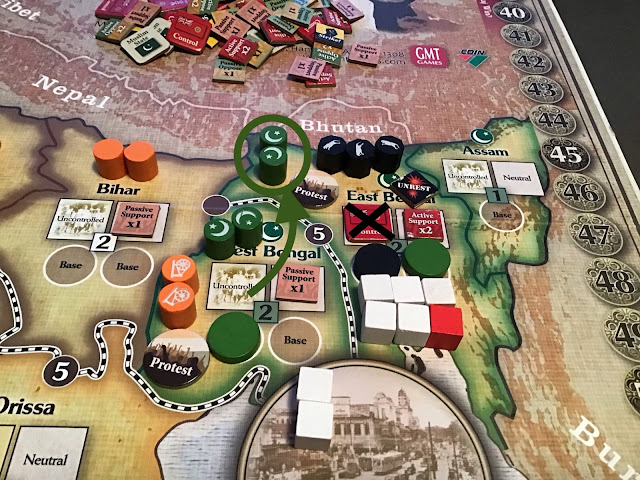 |
| The Muslim League has been penned into West Bengal but, emboldened by the successes in whittling away Raj forces, now demonstrates in neighbouring East Bengal, to where two activist units move. Active opponents (two active Muslim League units and three active Revolutionary activists plus two bases) outnumber Raj units. East Bengal is the latest province to slip from British control. |
Turn 16 - 2nd Action - Muslim League - Special Activity: Infiltrate
 |
| The demonstrations in East Bengal have a rapid impact as the Muslim League follow up by infiltrating another Sepoy unit. The British can no longer reply on local Indians to bolster their forces. |
---
Gandhi: Turn 17 - Unrest Grows as Revolutionaries Near Victory
Turn 17 - 1st Action - Revolutionaries - Special Activity - Infiltrate
Turn 17 - 1st Action - Revolutionaries - Command: Unrest
Turn 17 - 2nd Action - Raj - Pass
Gandhi: Turn 17 - Unrest Grows as Revolutionaries Near Victory
Turn 17 - 1st Action - Revolutionaries - Special Activity - Infiltrate
Turn 17 - 1st Action - Revolutionaries - Command: Unrest
Turn 17 - 2nd Action - Raj - Pass
---
Gandhi: Turn 18 - Raj Pegs Back Revolutionaries Before War Intervenes
Turn 18 - 1st Action - Raj - Operation: Sweep
Turn 18 - 1st Action - Raj - Special Activity: Govern
Turn 18 - 2nd Action - Muslim League - Play Event
---
Gandhi: Turn 19 - Gandhi Settles Nerves
Turn 19 - 1st Action - Congress - Special Activity: Satyagraha
Turn 19 - 1st Action - Congress - Operation: Demonstrate
Turn 19 - 2nd Action - Revolutionaries - Play Event
Gandhi: Turn 18 - Raj Pegs Back Revolutionaries Before War Intervenes
Turn 18 - 1st Action - Raj - Operation: Sweep
Turn 18 - 1st Action - Raj - Special Activity: Govern
Turn 18 - 2nd Action - Muslim League - Play Event
---
Gandhi: Turn 19 - Gandhi Settles Nerves
Turn 19 - 1st Action - Congress - Special Activity: Satyagraha
Turn 19 - 1st Action - Congress - Operation: Demonstrate
Turn 19 - 2nd Action - Revolutionaries - Play Event
 |
| Finding themselves squeezed out in the north, the Revolutionaries turn their attention to the middle of country. Inspired by articles in Gandhi’s Young India newspaper, the take their protests to two key railways, threatening 8 points worth of resources to the British. This is a new headache with which Irwin must deal. |
---
Gandhi: Turn 20 - Muslim League Numbers Increase Across the North
Turn 20 - 1st Action - Muslim League - Special Activity: Negotiate
Turn 20 - 1st Action - Muslim League - Operation: Rally
Turn 20 - 2nd Action - Raj - Limited Operation: Deploy
---
Gandhi : Campaign Round 2 - Imperialist Governor General Heads for India
Gandhi: Turn 20 - Muslim League Numbers Increase Across the North
Turn 20 - 1st Action - Muslim League - Special Activity: Negotiate
Turn 20 - 1st Action - Muslim League - Operation: Rally
Turn 20 - 2nd Action - Raj - Limited Operation: Deploy
 |
| Irwin moves to bolster his dwindling numbers in the north, deploying a troop and five Sepoy units to Delhi and wresting control of the city. |
---
Gandhi : Campaign Round 2 - Imperialist Governor General Heads for India
- Check for Victory
Revolutionaries: 5 points (-10)
Congress: 4 points (-17)
Muslim League: 0 points (-15)
The Revolutionaries are the nearest to victory but none of the factions is close.
- Resources
- Support
- Redeploy & Reset
- State of the nation after two campaigns
---
Gandhi: Turn 21 - Unrest and Protest Greet New Governor General
Turn 21 - 1st Action - Revolutionaries - Operation: Unrest
Turn 21 - 2nd Action - Congress - Limited Operation: Civil Disobedience
---
Gandhi: Turn 22 - First Muslim State Created in Punjab
Turn 22 - 1st Action - Muslim League - Play Event
Turn 22 - 2nd Action - Raj - Operation: Deploy
Turn 22 - 2nd Action - Raj - Special Activity: Martial Law
---
Gandhi: Turn 23 - Revolutionaries Rise, Then Fall
Turn 23 - 1st Action - Revolutionaries - Special Activity: Aid
Turn 23 - 1st Action - Revolutionaries - Operation: Unrest
Turn 23 - 2nd action - Congress - Play Event
---
Gandhi: Turn 24 - Muslim Independence Gathers Pace in the North, the Raj Fights Back in the South
Gandhi: Turn 21 - Unrest and Protest Greet New Governor General
Turn 21 - 1st Action - Revolutionaries - Operation: Unrest
Turn 21 - 2nd Action - Congress - Limited Operation: Civil Disobedience
---
Gandhi: Turn 22 - First Muslim State Created in Punjab
Turn 22 - 1st Action - Muslim League - Play Event
Turn 22 - 2nd Action - Raj - Operation: Deploy
Turn 22 - 2nd Action - Raj - Special Activity: Martial Law
---
Gandhi: Turn 23 - Revolutionaries Rise, Then Fall
Turn 23 - 1st Action - Revolutionaries - Special Activity: Aid
Turn 23 - 1st Action - Revolutionaries - Operation: Unrest
Turn 23 - 2nd action - Congress - Play Event
 |
| The Revolutionaries over-stretch themselves. They rob a train near Karkori in the United Provinces, prompting a backlash that sees 40 of them arrested and 4 Eventually hanged. Three units are gathered up hiding in Madras Presidency and another in Karachi. In playing the event, the Congress faction has clipped the Revolutionaries’ wings, helping not just themselves but the Raj in the process. [It’s worth noting that in a multi-player game, the level of inter-factional cooperation must be a significant and enjoyable feature of the COIN games. In a solo play through, this emerges more obliquely, as in this instance.] |
---
Gandhi: Turn 24 - Muslim Independence Gathers Pace in the North, the Raj Fights Back in the South
Turn 24 - 1st Action - Muslim League - Play Event
Turn 24 - 2nd Action - Raj - Operation: Sweep
Turn 24 - 2nd Action - Raj - Special Activity: Govern
---
Gandhi: Turn 25 - Revolutionaries Refuse to Lie Down
Turn 25 - 1st Action - Revolutionaries - Operation: Rally
Turn 25 - 1st Action - Revolutionaries - Special Activity: Infiltrate
Turn 25 - 2nd Action - Congress - Pass
The Congress get to play first next turn so, rather than be restricted to a limited operation by playing now, they pass.
---
Gandhi: Turn 26 - Gandhi Tries to Regain Momentum
Turn 26 - 1st Action - Congress - Special Activity: Satyagraha
Turn 26 - 1st Action - Congress - Operation: Rally
Turn 26 - 2nd Action - Muslim League - Play Event
Turn 24 - 2nd Action - Raj - Operation: Sweep
Turn 24 - 2nd Action - Raj - Special Activity: Govern
---
Gandhi: Turn 25 - Revolutionaries Refuse to Lie Down
Turn 25 - 1st Action - Revolutionaries - Operation: Rally
Turn 25 - 1st Action - Revolutionaries - Special Activity: Infiltrate
Turn 25 - 2nd Action - Congress - Pass
The Congress get to play first next turn so, rather than be restricted to a limited operation by playing now, they pass.
---
Gandhi: Turn 26 - Gandhi Tries to Regain Momentum
Turn 26 - 1st Action - Congress - Special Activity: Satyagraha
Turn 26 - 1st Action - Congress - Operation: Rally
Turn 26 - 2nd Action - Muslim League - Play Event
---
Gandhi: Turn 27 - Revolutionaries Exert Grip on East Bengal
Turn 27 - 1st Action - Revolutionaries - Special Activity: Infiltrate
Turn 27 - 1st Action - Revolutionaries - Operation: Unrest
Turn 27 - 2nd Action - Raj - Limited Operation: Sweep
---
Gandhi: Turn 28 - Protests, Railway Occupations, Gandhi Arrested, Crisis
Gandhi: Turn 27 - Revolutionaries Exert Grip on East Bengal
Turn 27 - 1st Action - Revolutionaries - Special Activity: Infiltrate
Turn 27 - 1st Action - Revolutionaries - Operation: Unrest
Turn 27 - 2nd Action - Raj - Limited Operation: Sweep
---
Gandhi: Turn 28 - Protests, Railway Occupations, Gandhi Arrested, Crisis
Turn 28 - 1st Action - Congress - Operation: Civil Disturbance (Part 1)
Turn 28 - 1st Action - Congress - Special Activity: Satyagraha
 |
| Gandhi then pulls a smart move. A Special Activity can be played in the midst of an Operation. In this case, Gandhi marches south to Madras Presidency. Once there, he attracts a new follower. |
Turn 28 - 1st Action - Congress - Operation: Civil Disturbance (Part 2)
Turn 28 - 2nd Action - Muslim League - Play Event
With both unity and restraint at 1, India has descended into crisis.
Turn 28 - Crisis
Gandhi: Turn 29 - Carrot and Stick Approach from the Raj Reaps Rewards
Turn 29 - 1st Action - Raj - Special Activity: Govern
Turn 29 - 1st Action - Raj - Operation: Assault
Turn 29 - 2nd Action - Revolutionaries - Play Event
---
Gandhi: Turn 30 - Muslim Independence Comes a Step Closer
Turn 30 - 1st Action - Congress - Play Event
Turn 30 - 2nd Action - Muslim League - Operation: Rally
Turn 30 - 2nd Action - Muslim League - Special Activity: Negotiate
---
Gandhi: Turn 31 - More Arrests and Activity on the Railways
Turn 31 - 1st Action - Raj - Special Activity: Martial Law
Turn 31 - 1st Action - Raj - Operation: Garrison
Turn 31 - 1st Action - Raj - Operation: Garrison
---
Campaign Round 3
Check for Victory
- Raj: 32 points (-7 from their victory target)
- Revolutionaries: 12 points (-3)
- Congress: 8 points (-13)
- Muslim League: 12 points (-3)
All factions improved their positions but the Muslim League, who have had a superb campaign, and the Revolutionaries are closest to achieving their aims. The most disappointed will be Gandhi who has failed to generate widespread opposition.
Resources
There are no protests on any railways and because Lord Reading managed to get two cubes onto each of the railway lines that had activists, none of those railways go on strike. With all cities under Raj control, the British coffers are filled to their maximum (50 points). However, they must then pay 2 resources for every activist and Gandhi in jail. This costs 14 resources, a hefty price to pay.
Support
Redeploy & Reset
State of the nation after three campaigns
---
Gandhi: Turn 32 - Gandhi Tries to Muster Support but Raj Gains in Strength
Turn 32 - 1st Action - Congress - Operation: Civil Disobedience (Part 1)
Turn 32 - 1st Action - Congress - Special Activity - Satyagraha
Turn 32 - 1st Action - Congress - Operation: Civil Disobedience (Part 2)
Turn 32 - 2nd Action - Raj - Play Event
 |
| Congress protests break out in Sind and East Bengal. However, these are risky tactics as they can benefit the Muslim League as well. |
Turn 32 - 1st Action - Congress - Special Activity - Satyagraha
 |
| Gandhi interrupts his operation to march to the far south and see what opposition he can drum up in Madras Presidency. His arrival there brings out an activist in the region. |
Turn 32 - 1st Action - Congress - Operation: Civil Disobedience (Part 2)
 |
| Now Gandhi completes his operation, sparking protests in Madras Presidency. This sends the Congress piece active, thereby removing British control from the province. |
Turn 32 - 2nd Action - Raj - Play Event
---
Gandhi: Turn 33 - Muslim Independence Nears Reality but all Factions in Play
Turn 33 - 1st Action - Revolutionaries - Operation: Rally
Turn 33 - 1st Action Revolutionaries - Special Activity: Infiltrate
Turn 33 - 2nd Action - Muslim League - Play Event
—-
Gandhi: Turn 34 - Gandhi Marches Again While Sepoys Head for Punjab
Turn 34 - 1st Action - Congress - Operation: Civil Disobedience
Turn 34 - 1st Action - Congress - Special Activity: Satyagraha
Turn 34 - 2nd Action - Raj - Limited Operation: Sweep
—
Gandhi: Turn 35 - Violence and Bloodshed Rocks British Empire
Turn 35 - 1st Action - Revolutionaries - Operation: Unrest
Turn 35 - 1st Action - Revolutionaries - Special Activity: Assassinate
Gandhi: Turn 33 - Muslim Independence Nears Reality but all Factions in Play
Turn 33 - 1st Action - Revolutionaries - Operation: Rally
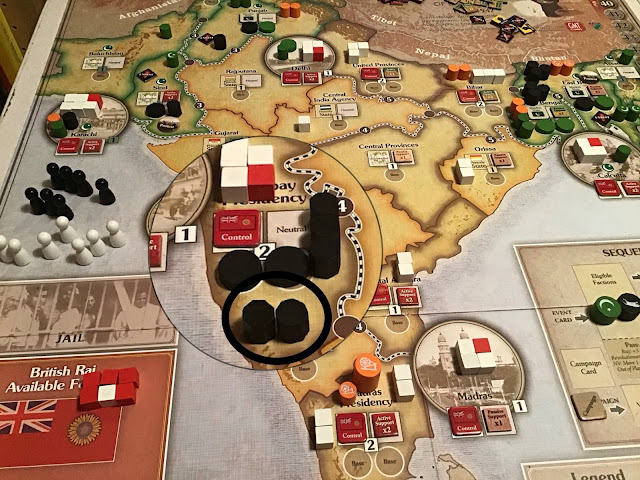 |
| Revolutionary forces are themselves close to victory but need to sow further unrest to reach that goal. Again utilising their two bases in Bombay Presidency, they rally two new units there. |
Turn 33 - 1st Action Revolutionaries - Special Activity: Infiltrate
 |
| The Revolutionaries now seek to drive home their advantage and infiltrate a Sepoy unit, bolstering their forces in Bombay Presidency further. |
Turn 33 - 2nd Action - Muslim League - Play Event
—-
Gandhi: Turn 34 - Gandhi Marches Again While Sepoys Head for Punjab
Turn 34 - 1st Action - Congress - Operation: Civil Disobedience
Turn 34 - 1st Action - Congress - Special Activity: Satyagraha
Turn 34 - 2nd Action - Raj - Limited Operation: Sweep
—
Gandhi: Turn 35 - Violence and Bloodshed Rocks British Empire
Turn 35 - 1st Action - Revolutionaries - Operation: Unrest
Turn 35 - 1st Action - Revolutionaries - Special Activity: Assassinate
 |
| The Muslim League are limited in their options so play the event in which the backing of communists and trade unionists lead to strikes that attract further support to their cause, largely from among Revolutionary supporters who are impressed by the Communists’ organisational skills. |
—
Gandhi: Turn 36 - Sepoys Impose Martial Law as Support for Gandhi Swells
Turn 36 - 1st Action - Raj - Operation: Deploy
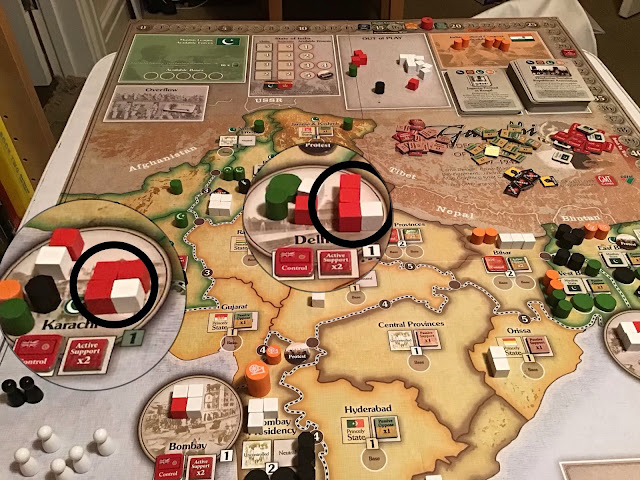 |
| India seems to be slipping away from the British. Lord Chelmsford is fighting on multiple fronts and, desperate to get more troops in place, deploys to Karachi and Delhi. Is it too little, too late? |
Turn 36 - 1st Action - Raj - Special Activity: Martial Law
 |
| In response to the violence meted out to British troops by Revolutionaries in the previous turn, Lord Chelmsford retaliates, declaring martial law in Bombay Presidency and Punjab. Congress and Muslim League activists are cleared from both areas, protests quelled and opposition in Punjab suppressed. Unrest, however, increases to the delight of the Revolutionaries. It is a case of my enemy’s enemy is my friend. |
Turn 36 - 2nd Action - Congress - Play Event
 |
| After the Communists have moved in the north, Socialists move in the south.The Hindustan Socialist Republican Association and the Philosophy of the Bomb wins further support and increases the growing levels of opposition to the Raj, which drops in Madras Presidency and turns to opposition in Bombay Presidency. With opposition now spreading across India, Gandhi is just two points short of his victory total. |
—
Gandhi: Turn 37 - Revolutionary Forces Spread Cross Country
Turn 37 - 1st Action - Revolutionaries - Special Activity: Infiltrate
 |
| The Revolutionaries continue to wreak havoc in Bombay Presidency, continuing to infiltrate Sepoy units who are starting to desert the British cause in droves. |
Turn 37 - 1st Action - Revolutionaries - Operation: March
 |
| Having built up a mass of guerillas in Bombay Presidency, the Revolutionaries now head for regions currently without unrest but which are ripe for disorder: Karachi and West Bengal. Unrest in either place would take the Revolutionaries into winning territory. |
Turn 37 - 2nd Action - Muslim League - Limited Operation: Demonstrate
 |
| The Muslim League is limited in its options but shifts two activists from West to East Bengal, perhaps with a view to removing the unrest there and clipping the wings of the Revolutionaries and their violent intent. |
—
Gandhi: Turn 38 - Gandhi Jailed while Raj Clears Punjab of its Opponents
Turn 38 - 1st Action - Raj - Operation: Assault
 |
| Following up his earlier martial law in Punjab, Chelmsford now goes on the assault. Punjab, which had been emptied of Muslim League supporters is now cleared of a Revolutionary unit, as well as one of their bases and a Muslim League bases. Further south, Gandhi is thrown in jail together with Congress supporters picked up in Madras Presidency. The moves are designed to clip the wings of the British opponents but don’t yet deliver any additional points. |
Turn 38 - 1st Action - Raj - Special Activity: Govern [followed by automatic Congress Protests]
 |
| In an attempt to gain those additional points of support, Chelmsford buys his way to active support in Madras Presidency and to remove one of the unrest markers in Punjab. However, this is expensive. He is running out of money and is going to need some useful card events if he is to snatch victory. Congress is then allowed to place two protests at the end of a Raj turn in which the assault operation was used. Protests breaks out in response to Gandhi’s arrest in Bombay Presidency as well as in West Bengal. |
Turn 38 - 2nd Action - Congress - Limited Operation: Rally
 |
| Congress really needs to accelerate its activities but it is limited to a single rally action in Madras Presidency, where two activists reappear. However, the far south has never brought them a long-lasting presence so there is little reason to think things will be any different this time. |
—
Gandhi: Turn 39 - Muslim Protests Break Out in Far North
Turn 39 - 1st Action - Muslim League - Operation
Turn 39 - 2nd Action - Revolutionaries - Pass
In fact, while the revolutionaries are prevented from playing the event this turn, if they pass now they will be first player in the next turn and able then to take advantage of a powerful event.
—
Gandhi: Turn 40 - The Rule of the Raj Appears Nearly Over But Who Will Control India?
Turn 40 - 1st Action - Revolutionaries - Play Event
Turn 40 - 2nd Action - Raj - Pass
The British are desperately short of money (down to 7 resources). To have any chance of victory they need more. The only way to get more is to pass, which brings them 3 additional resources.
Turn 40 - 2nd Action - Congress - Special Activity: Persuade
Turn 40 - 2nd Action - Congress - Operation: Non-Cooperation
—
Gandhi: Turn 41 - British Fightback in Punjab Can’t Stop Muslim Independence Movement
Turn 41 - 1st Action - Raj - Operation: Sweep
Turn 41 - 1st Action - Raj - Special Activity: Govern
Turn 41 - 2nd Action - Muslim League - Play Event
—-
Turn 39 - 1st Action - Muslim League - Operation
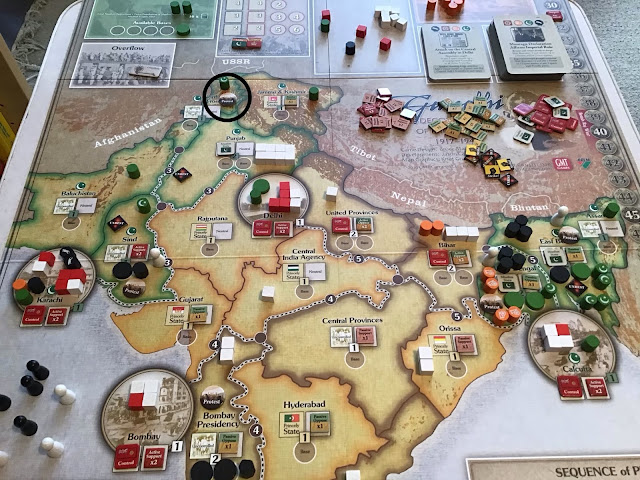 |
| The Muslim League is in the lead and doesn’t want to give unnecessary opportunities to its opponents. Therefore, in order to stop the Revolutionaries being able to play a powerful event, the League chooses to carry out a sole operation, generating a protest in the Northern Frontier. |
Turn 39 - 2nd Action - Revolutionaries - Pass
In fact, while the revolutionaries are prevented from playing the event this turn, if they pass now they will be first player in the next turn and able then to take advantage of a powerful event.
—
Gandhi: Turn 40 - The Rule of the Raj Appears Nearly Over But Who Will Control India?
Turn 40 - 1st Action - Revolutionaries - Play Event
 |
| The bombing of the Central Legislature in New Delhi is another act of bloodshed but brings huge results for the forces of revolution. The waves of unrest it causes ripple into Bihar and as far south as Madras Presidency which all of a sudden no longer looks secure for the British. Just as seriously, the Revolutionaries have now reached their victory requirement of 15 points. India is on a knife-edge. |
Turn 40 - 2nd Action - Raj - Pass
The British are desperately short of money (down to 7 resources). To have any chance of victory they need more. The only way to get more is to pass, which brings them 3 additional resources.
Turn 40 - 2nd Action - Congress - Special Activity: Persuade
 |
| Gandhi, watching on from jail, is desperate for the Revolutionaries to be pegged back. Congress activists work to persuade them to renounce their violence and enjoy some success in exposing guerilla units in West Bengal and Bombay Presidency. It makes them more vulnerable and may offer a way of denying them victory. |
Turn 40 - 2nd Action - Congress - Operation: Non-Cooperation
 |
| Congress may have brought the curtain down on British rule in India. Acts of non-cooperation in Madras Presidency and West Bengal follow on from the earlier persuasion efforts. Support for the Raj drops in the south (denying the British of two points in the process), while opposition moves from passive to active in the West Bengal tinderbox. It brings Congress to within two points of victory but also pushes the Muslim League two points further past the winning post. |
—
Gandhi: Turn 41 - British Fightback in Punjab Can’t Stop Muslim Independence Movement
Turn 41 - 1st Action - Raj - Operation: Sweep
 |
| The game can now end at any point now, whenever the final campaign card is turned up. This could be the Raj’s final action in India. They may, alternatively, have about three more but it is hard to see how they get enough points. Still, Lord Chelmsford does what he can, sweeping forces into Bombay Presidency and Sind, where control is gained for the time being. |
Turn 41 - 1st Action - Raj - Special Activity: Govern
 |
| The British are not ready to yield the jewel in their crown without a final fight. Dramatic last attempts to retain control by governing sees their suppression of Muslim independence in Punjab completed, as the last unrest is removed before the state relinquishes its hard fought independent status. Will the League fight back? |
Turn 41 - 2nd Action - Muslim League - Play Event
 |
| The loss of Punjab is a blow but the Muslim League has been playing a long game. The declaration of independence is more than just words. Protests in Sind, Northern Frontier and East Bengal come to an end amidst the jubilation with support in those areas drifting away from the British towards opposition, to the gain of both the League and Congress. |
—-
Gandhi: Turn 42 - Revolutionary Attacks Foiled
Turn 42 - 1st Action - Revolutionaries - Operation: Attack
 |
| The Revolutionaries decide to go for a single operation to deny Congress a chance to play a powerful event. In seeking to sow the unrest they need to get them over the victory line, they go on the attack. First they target West Bengal, needing to roll less the number of guerillas they have there [3]. They roll a ‘5’. The attack fails. A further dice roll allows them to attach a second regions. This time they go for Karachi, again with three guerillas. They roll a ‘4’. Another failure. Another failed dice roll prevents a further attack. |
Turn 42 - 2nd Action - Congress - Pass
In a risky move, Congress decides to pass so they can carry out a full action in the next turn, when they are first player. However, if the next card turned up is the last Campaign card, they won’t get the chance to act.
—-
Gandhi: Turn 43 - Congress Negotiation and British Violence Create Fresh Turmoil
Turn 43 - 1st Action - Congress - Operation: Rally
 |
| The gamble to pass in the previous turn looks to have paid off. Congress rallies with new supporters emerging in Sind, Bombay Presidency and Madras Presidency, where the Raj forces are now outnumbered and lose control of the province. |
 |
| With the denouement almost upon us, the most dramatic of interventions which throws the future of India into turmoil. Perhaps the Muslim League became complacent, because they did not see Congress turning to that most peaceful of actions: negotiation. Because Congress pieces outnumber League pieces by one in West Bengal, they are able to remove the protest there but, most tellingly the self-declared Muslim state. Meanwhile, the Raj’s willingness to negotiate means that opposition, formerly active, now reverts to neutrality. In one move, the Muslim League loses six points and Congress four. Suddenly, no-one is in a winning position. |
Turn 43 - 2nd Action - Raj - Assault
 |
| If this is to to be the Raj’s last action, its brutality shows why Indians have been so desperate to turf them out. A full-out assault in Bombay Presidency kills two Congress activists and three guerillas. It is a heavy price to pay for regaining control of the province and sparks a protest in United Provinces. |
—-
Gandhi: Turn 44 - Assam Declares Independence as League Regroups
Turn 44 - 1st Action - Muslim League - Special Activity: Negotiate
Turn 44 - 1st Action - Muslim League - Operation: Demonstrate
Turn 44 - 2nd Action - Revolutionaries - Limited Operation: Rally
Turn 44 - 1st Action - Muslim League - Special Activity: Negotiate
 |
| This may be the evidence that peaceful means get you what you want. A quiet piece of negotiation by the Muslim League turns Assam, on India’s far eastern fringe into a Muslim State, gaining a degree of support for the soon to be departed British. It is enough to put the League into a winning position again. |
Turn 44 - 1st Action - Muslim League - Operation: Demonstrate
 |
| With an eye on re-establishing a Muslim state into West Bengal, the Muslim League now demonstates, sending two activist pieces there from neighbouring East Bengal. |
Turn 44 - 2nd Action - Revolutionaries - Limited Operation: Rally
 |
| Seeking final places in which to sow discord, the Revolutionaries place a new base in Karachi. |
—
Gandhi: Turn 45 - Internal Divisions Scupper Muslim Independence Hopes
Turn 45 - 1st Action - Raj - Play Event
Turn 45 - 2nd Action - Congress - Special Activity: Satyagraha
Turn 45 - 2nd Action - Congress - Operation: Non-Cooperation
Turn 45 - 1st Action - Raj - Play Event
 |
| Chelmsford is almost out of money so, playing the event, the British cynically exploit east-west divisions to undermine the independence movement in West Bengal, where Congress and Revolutionary pieces are as numerous as those from the Muslim League. West Bengal’s status as a Muslim State is lost and with it four points for the League. It is a crushing late blow. |
 |
| The British risk losing control of one of their provinces to a persuade action if they choose not to release Gandhi. He’s thrown out of jail and heads to Bombay Presidency where he ends the protest and removes one of the two unrest markers there. |
Turn 45 - 2nd Action - Congress - Operation: Non-Cooperation
 |
| Congress will have hoped to be active in more regions but, instead, they are restricted to just Madras Presidency where their non-cooperation removes the remaining support from the British, turning the state neutral. |
—
Gandhi: Turn 46 - India’s Revolutionaries on the Verge of Victory
Turn 46 - 1st Action - Revolutionaries - Special Activity: Aid
Turn 46 - 1st Action - Revolutionaries - Operation: Unrest
Turn 46 - 2nd Action - Muslim League - Pass
In a high-wire act that has a 50/50 chance of success, the Muslim League passes to give themselves a chance of playing first in the next turn, when a powerful event might get them across the victory line. Will the gamble work?
—
Gandhi: Game End and Final Thoughts
Game End: India Collapses into Disastrous Civil Way
The Muslim League’s attempt to pass and play a powerful event fails: the final campaign card is turned up and the game ends.
The points are totted up to see if anyone has reached their target:
Finis
Gandhi: Turn 46 - India’s Revolutionaries on the Verge of Victory
Turn 46 - 1st Action - Revolutionaries - Special Activity: Aid
 |
| In what is almost certain to be their last turn, the Revolutionaries set up a final attempt to generate the unrest they need for victory. Foreign aid helps the send guerillas underground in West Bengal and Karachi, perhaps in preparation for a final act of violence. |
Turn 46 - 1st Action - Revolutionaries - Operation: Unrest
 |
| The plan worked. Having been sent underground, a cell in West Bengal was able to start agitating behind the scenes, sending the province back into a state of unrest. An activation roll to continue acting elsewhere failed, but this may be all the Revolutionaries needed. |
Turn 46 - 2nd Action - Muslim League - Pass
In a high-wire act that has a 50/50 chance of success, the Muslim League passes to give themselves a chance of playing first in the next turn, when a powerful event might get them across the victory line. Will the gamble work?
—
Gandhi: Game End and Final Thoughts
Game End: India Collapses into Disastrous Civil Way
The Muslim League’s attempt to pass and play a powerful event fails: the final campaign card is turned up and the game ends.
The points are totted up to see if anyone has reached their target:
- Raj: 30 points (-9 short of their target)
- Congress: 17 points (-4)
- Muslim League: 8 points (-7)
- Revolutionaries: 16 points (+1)
Revolutionaries win...
The British leave India in haste as the country descends into civil war, with violence focussed around the outskirts of Bombay, in Karachi and most brutally in Bengal. It is a disastrous legacy, with Muslim hopes quashed in the final few turns and Gandhi’s Congress never gaining the momentum needed to overcome the appeal of violent insurrection.
This was an extraordinary experience and a perfect Covid-19 distraction, though logging each move takes all the pace away from what I suspect is game play that can have plenty of momentum. I look forward one day to playing it around the table with three other people.
That said, the Arjuna AI system, played smoothly and only rarely made decisions I thought were questionable.
As a first time player, I made countless dumb decisions but, even so, it is tough being the British, fighting on so many different fronts. What I came to realise at the end was how important resource management is. Shifting levels of support is costly and I ran out of money in the critical last few rounds.
In this game, Congress played passively and never gained momentum. Constantly being drawn to the 2 population areas in Muslim territories meant they never touched those central Indian states that might swung the game their way. Any gains they made in Muslim provinces inevitably helped the Muslim League too.
As for the Muslim League, they were interesting to observe: slow to get going but, once their bases were out on the boards, increasingly powerful. Their narrative arc felt the most compelling. The end game could have come a few turns earlier when they would have won handsomely. However, they were stuffed by a strange, late negotiate decision by Congress in Bengal which lost the League six points in one go. They never recovered.
The Revolutionaries meanwhile were hard to quash. Hit them and they came back and back and back. Get five bases out and after that they only need to focus on a few provinces to deliver victory. I think the AI gives them an easier ride than human opponents might. It was left almost entirely to the British to deal with them when the non-violent factions might have done more to clip their wings.
Conclusion
This is an extraordinary game and game-system. It’s fascinating to engage with the history of India’s decolonisation through a game, particularly as the education system I came through in 1980s Britain had nothing interesting to say about our colonial history and its end.
The fact is, the British will lose (even if they win on the points track) and the game is superb at capturing that drift towards independence. The three Indian factions will gain over time, sometimes making leaps forward, then being pushed back before inching forward once more.
Sometimes you have to finesse the narrative: what does Congress ‘removing’ troops represent? They’re not killing so what does that removal of a Raj cube denote? At times, the cards emerge in a way that makes no historical sense but if that’s going to bother you don’t play a counter-factual game. It can also feel odd when a region becomes a Muslim State and yet support for the Raj remains active. Maybe I was playing a rule wrong.
However, those quibbles all pale into insignificance compared to the authentic story that emerges; the compromises that confront you from having competing yet complementary interests with other factions; and the mental challenge that is contained within a smooth game play.
I hope anyone who followed some of this play through found it offered a useful insight into how the game works. For me, it was both fun and a valuable distraction during lockdown and a reaffirmation of what a great hobby this is.
Finis



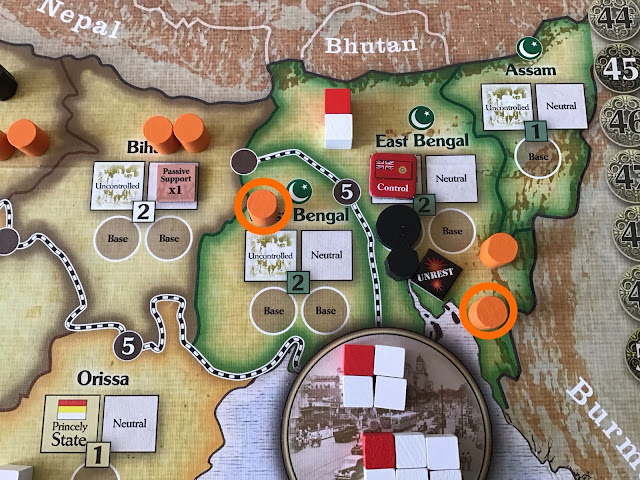















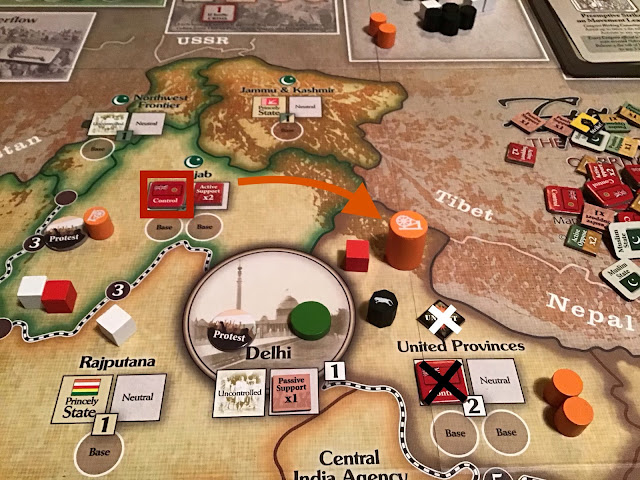











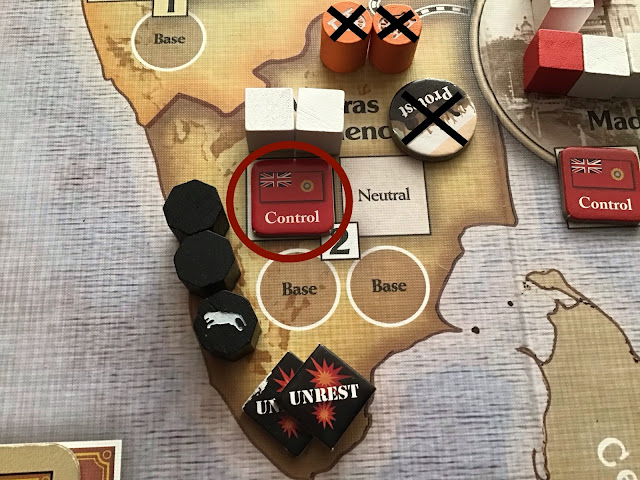












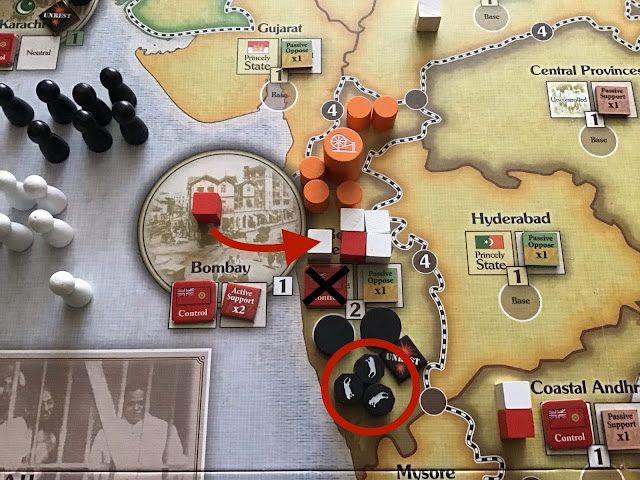





























Comments
Post a Comment